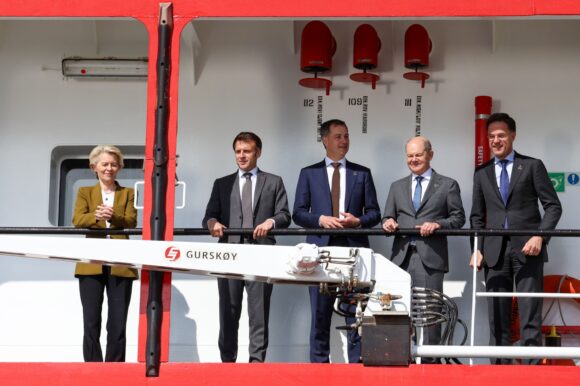Security advisers from the North Sea nations agreed to work out a pact to jointly protect critical sub-sea gas pipelines and power cables, telecoms connections and wind farms.
Several nations attending the North Sea Summit in Belgium on Monday will work on an agreement that will allow the use of drones to monitor key sites, according to a document seen by Bloomberg News. The plan is to set up a cross-border information sharing platform for security incidents and enable action to be taken to help in the territorial waters of the member countries.
Since the Nord Stream attacks in September, NATO members have increased monitoring with satellites, aircraft, ships and submarines for the North and Baltic seas. The alliance has yet to publicly identify who carried out the pipeline blasts, but fears have increased that European undersea infrastructure may be at risk of a covert attack by Russia in retaliation for sanctions related to its invasion of Ukraine.
Russian Hackers Target Western Critical Infrastructure, UK Warns
Norway is now the biggest supplier of pipeline gas to Europe and disruption is a top concern but there are signs that electricity cables and wind farms are also targets. The near-impossible task of protecting miles of sub-sea infrastructure has been thrown into the spotlight following the blasts carried out in the Baltic Sea.
“As the past year has brutally shown, we need to effectively protect our offshore industry,” Olaf Scholz, German Chancellor, told journalists in Ostend. “The EU and NATO play an important role.”
The threat is growing. The UK said last week it had seen attempts by Russian hackers to damage or destroy critical national infrastructure. The Belgian government also reported 30 Russian naval vessels passed through the English channel last year staying in international waters. Those included a frigate, a destroyer and a submarine.
Nine nations are attending the summit in the Belgium port city of Ostend, but it’s not clear how many will sign the pact, expected by the end of the year. It will build on a declaration by political leaders on Monday to protect assets and increase the security around infrastructure.
The EU has created a joint task force with NATO to work on a resilience program for cyber security and energy, according to Ursula Von Der Leyen, president of the European Commission. The results will be presented at a NATO summit in July she said.
“The energy sector is getting more and more interwoven with geopolitical risks,” Fatih Birol, executive director of the International Energy Agency said in an interview. “We are seeing there might be an additional job for the authorities.”
Green Energy
At Monday’s summit, the nine governments pledged to turn the North Sea into one of the world’s biggest hubs for renewable energy. The nations — which also includes Luxembourg, Denmark, Ireland, the Netherlands and Belgium — signed a declaration to accelerate the building of offshore wind projects on a “massive scale”.
The combined target is to install 120 gigawatts of offshore wind capacity in the North Sea by 2030 and 300 gigawatts by 2050.
| Offshore wind goals |
|
The countries will work together to build more electricity cables connecting North Sea offshore wind farms to key parts of Europe’s grid. Other key areas of collaboration will focus on spurring a market for renewable hydrogen and encouraging carbon capture and storage — where the North Sea is seen as having a lot of potential to store injected carbon dioxide.
“We need to build European energy motorways, essentially, to harness that offshore energy,” Leo Varadkar, Irish Prime Minister, said at the summit.
Leaders will also meet with executives from key companies involved in building and developing the projects. Despite political rhetoric supporting renewables, no final investment decisions were made in offshore wind farms last year. Raw material costs, rising interest rates and inflation has made it much more risky to sign off on big projects.
“We need to massively ramp up European wind supply chains,” said Sven Utermöhlen, chair of lobby group WindEurope Chair and CEO of RWE Offshore Wind. “Taking into account inflation developments for increasing the investment certainty of both manufacturers and developers and thereby, allowing the lowest financing cost.”
–With assistance from Katharina Rosskopf.
Photograph: Attendees aboard a boat at the North Sea Summit in Ostend, Belgium on April 24, 2023. Photo credit: Valeria Mongelli/Bloomberg
Was this article valuable?
Here are more articles you may enjoy.



 Zurich to Buy AIG’s Travel Insurance Business for $600 Million
Zurich to Buy AIG’s Travel Insurance Business for $600 Million  GEICO Tops Progressive With Higher J.D. Power Scores
GEICO Tops Progressive With Higher J.D. Power Scores  BlackSuit Cybercrime Gang Blamed in CDK Hack That Roiled Car Dealers
BlackSuit Cybercrime Gang Blamed in CDK Hack That Roiled Car Dealers  Big ‘I’ Report: Independent Agency Channel Placed 62% of Premiums in 2023
Big ‘I’ Report: Independent Agency Channel Placed 62% of Premiums in 2023 

